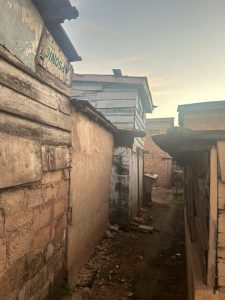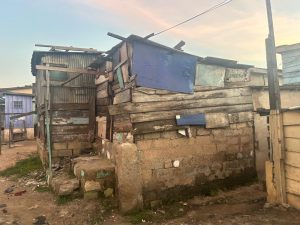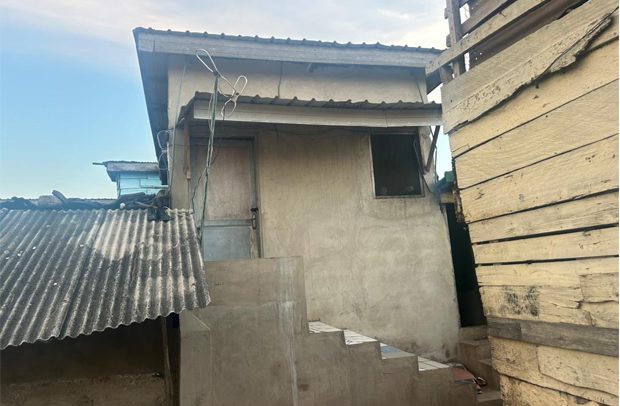Front view one of such ‘high-rise’ buildings.
LITTERED all over the community are brick buildings, taller than the average height of other buildings, mainly made of wood, springing up at a fast rate.
Sahara-Odawna, is a small community in Adabraka, a suburb of Accra. The area was once full of sea sand making it look like the famous Sahara Desert hence the name ‘Sahara’.
The popularity of the area is attributed mainly to the existence of a football park – the Sahara Park – sitting right in the heart of the community. The park has produced famous football stars who have gone through the national level to the international stage in their careers. One of such players is Razak Ibrahim.

A normal building is sandwiched by ‘high-rise’ buildings.
Flood-Love Affair
In recent years, the area’s popularity has been tagged with its ‘love affair’ with floods. Such is the depth of this love affair that the word “Sahara-Odawna” has become synonymous with it.
The flooding menace in the area is largely facilitated by the ‘Odaw Lagoon’ which traces its roots far beyond Accra and ends in the Atlantic Ocean.
Reports say the lagoon receives water from areas as far as Aburi in the Eastern Region and makes its way into the Atlantic Ocean.
For many people, the community is a flood-prone area and that nothing can be done to save the situation by any government or power that be.
However, sources say that the area never experienced floods until the late 1990s when the Odaw Lagoon was constructed by Ghana’s first Head of State in the Fourth Republic, Jerry John Rawlings.
According to some old folks, in place of the stretch of the lagoon within the community, once lay a beautiful stream in which some individuals carried out fishing expeditions regularly.
A few years following the construction of the lagoon, the area began experiencing floods, but not on a regular basis.
Within the last seven to ten years however, the rate at which the community experiences floods has increased, with many residents describing it as “unprecedented”.
“Yes, we experienced floods, but not as frequent as we see it today”, Madam Akosua Wletsu, a resident said.
According to her, unlike before, especially within the last seven years, they are not able to predict the rainfall patterns and so almost always fall victim to floods which eventually leave them displaced thereby losing their valuables, and on some rare occasions – like in 1995 – loved ones.
More damning is the report that quite on many occasions, the rains need not empty their bowels unto their corner of the earth before the lagoon overflowed it banks.
Residents say there had been occasions where the lagoon had overflown its banks due to rains elsewhere. And as the water makes its way into the Atlantic Ocean through the lagoon, it shares with the communities along its way, including Sahara Odawna, some of its goodies – floodwater.
Residents are consequently displaced even when there had been no downpour – heavy or light – in the community as a result.
In a community with about 90 per cent of its structures being wooden, their vulnerability to floods cannot be overstated.

Some of the ‘high-rise’ building at Sahara-Odawna were half wooden and half concrete.
‘High-Rise’ Buildings
In recent times, a new generation of home owners in the area have began putting up concrete/brick structures – an upgrade of what their parents and grandparents had in their days. Some also have their buildings being half wooden and half brick. But this time around, the new structures stand quite far away from the ground, unlike the old ones.
The foundations of the old wooden buildings are a little below ground level; but today, however, the foundations of most of these new buildings at Sahara-Odawna, are way above ground level.
This, the owners say, is in response to the menace of flooding they experience regularly.
For people who do not appear ready to leave anytime soon, these types of buildings come as their own way of escaping the sharp brunt of the floods.
Some residents raise their foundations to as high as six feet above ground level (others more); fill them with debris, mud and/orsand; floor them, before laying the bricks for the buildings.
According to Ishmael Foli, a resident and owner of one of such buildings, “the area is good and it’s a very happy place. I had to raise my building because of the rains. Previously when the rains came, the water easily entered my room so I thought of raising it so that the water will not enter my room when it rains again. And so far so good, water has not entered my room since last year when I completed the building “.
Residential buildings are not the only structures built in this manner, but also commercial ones. Wealthy shop owners have raised their shops high above ground level – also as an escape from the floods.
The general mood in the area towards the phenomenon is that, it would take a while for a sustainable solution to be developed and executed to curb the menace; but in the meantime, they have to protect their properties and their sleep whenever the rains came, especially at night.
Today, a good number of the old lowly wooden buildings are being replaced with ‘high-rise’ buildings while new ones are quickly springing up.
Impact
The effects of the floods on the community and its people have been dire, to say the least.
Even though the residents claim they do not live in fear of the floods anymore, they admit they are on a high alert whenever the clouds gather.
Some residents shared that even when away from home and they see the clouds gathering or rains pouring at wherever they may be, they do call to ascertain the situation back home.
On most occasions, they have had to return home abruptly so to protect their properties as the rains there could result in a flood situation back at home.
Irregular Rainfall Patterns
Dr. Yaw Agyeman Boafo (PhD), Senior Research Fellow (Integrated Ecosystems Assessment & Sustainability Science) at the University of Ghana, Legon, indicated that Ghana’s temperature over the last few years has seen “a small increase averagely” every year, which he noted gave rise to more heat otherwise known as global warming.
He explained that global warming , which is as result of increase in global temperature affects rainfall patterns in various regions of the globe.
According to him, rainfall in recent years has become “very variable”, with some areas experiencing unusually lots of it while other areas experience unusually more of it which affects livelihoods.
“There is less in some areas, and there is more in some areas. And so, if you are in Accra, or in an area like in many urban areas where we have destroyed all the plants, chances are that you are going to have very extreme temperatures and the rainfall will be more variable.”
Plight of Residents
For those who are not able to afford the means to raise their buildings, they can only hope and pray that the rains do not come; and even when they do, they [the rains] show some sense of empathy.
That however cannot be promised, especially in an era where the world and all its creatures and peoples are at the mercy of climate change.
This report is produced in fulfilment of the UNESCO and CIJ London Climate Change in News Media project facilitated by the Centre for Journalism Innovation and Development (CJID).
By Nii Adjei Mensahfio

